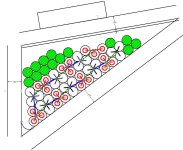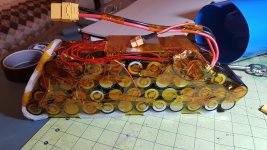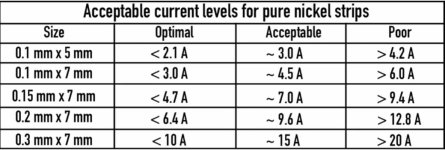SYOTR said:
The 5v sag does not seem excessive since at that voltage it is still well above the 48v rating of the controller and hubmotor.
the point about sag hasn't anything to do with the rating of the controller or motor.
it has to do with the internal resistance of the batteries. the higher that resistance is, the more sag there is at a particular current.
the more sag there is, the less power (watts) you get at teh controler, and thus the motor, since it's v * a = w.
i don't see the current you're drawing from it listed anywhere, so at the moment the only number you have is the volts, and so nothing can be determined.
you'll need to measure the actual current under load (like going up that hill) to determine what the actual wattage is, and the actual power loss from internal resistance is. (and also to find out how much of an upgrade you really might need for the controller; not knowing the present controller's limit means you don't know what you'd have to get to increase it). a cheap wattmeter in series with the battery-to-controller leads is the most useful way of doing that. They're anywhere from about $10 to $30; plenty of threads on es with suggestions and links.
so...let's say you double the current drawn from the battery. it may also double the voltage sag, so you might drop as much as 10v under the same conditions. if it did, it would also drop the watts you get out of the system (while increasing the watts wasted as heat inside the battery), and also slow it down because the lower voltage means the motor spins slower under the otherwise-same conditions.
fwiw, it's likely (but not guaranteed) that if you were using rc lipos before, they had a lower resistance than the cells in the battery you're using now, so that even though it's higher voltage, you may have been able to get more power from the rc lipos (less voltage sag per amp drawn). note that many cylindrical cells are sold as rated much higher than they can actually do without significant voltage sag. for instance, one might be sold as a 20a cell, but sag from 4v down to 3v while that much current is drawn, meaning 25% of the energy coming out if it is wasted as heat inside it! (when if it sagged less, you'd get more power / speed out of the motor).
the way to get less sag is to have less cell resistance, which either means better cells or more of them in parallel. if there's three sets in parallel now, and you added a fourth set in parallel, it would cut the resistance some (i'm not great with creating formulas, but it "feels like"

about 3/4 of what it was, so the voltage sag would be 3/4 of what it was. if it was 5v of sag before, it would only be 3.75v of sag now. to get half teh sag you'd need twice as many cells in parallel. and so on. or use cells with less internal resistance....
the controller current limit *could* be a bottleneck, but there are several possible ones.
if you want to know what the limiting factor for speed is, first just turn your bike upside down, make sure your speedometer sensor is on the motor wheel, and then rev it up to max. if the speed is much higher that way then when you're riding, you need more power to the wheel, rather than more voltage.
if the speed is not very much higher than when you're riding, you need more voltage (and probably more power, too).
keep in mind that it takes quite a lot more power to go just 5mph faster, once you get past around 20-25mph (depends on the aero of the bike/rider).
go to http://ebikes.ca/simulator, read the *entire* page so you know what everything is and how it works / is used, and then try different systems and conditions, so you can see the relationships between these things. you can even use custom battery packs so you can change the internal resistance to see how that affects the system.




